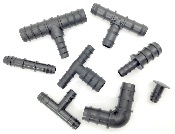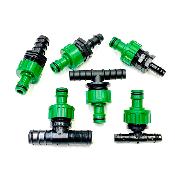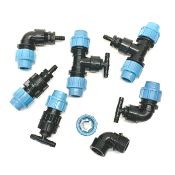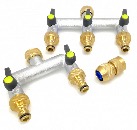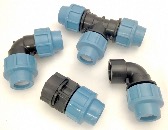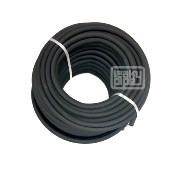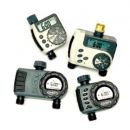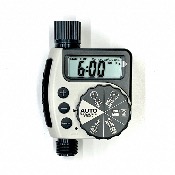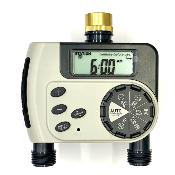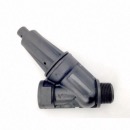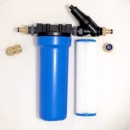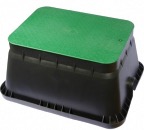FAQ - Planning your Irrigation SystemYou are designing a garden irrigation system? You have questions regarding the best method to implement an irrigation system? LeakyPipe irrigation systems provide efficiency and value for money. Does LeakyPipe save water compared to using a sprinkler? 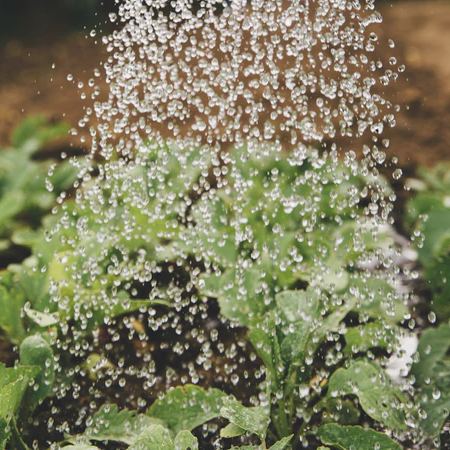 How to save water compared to a garden watering sprinkler?Applying water directly, or at least, near the target plant reduces water losses through wind effects, shadow effects, evaporation and run-off. Also, because the watering philosophy is "watering lower and slower”, it gives the user more margin of error on their watering times as well as being able to water larger areas for the same effort.
What do I do with the unattached, open end of the LeakyPipe? What to do with the open end of the LeakyPipe?The ends do need sealing. You can either fold the end of the lateral over on itself and retain the fold with a cable tie or short sleeve section of 20mm supply pipe polytube. However, it is tidier and more reliable to use a 12mm end plug. (See 'end plug - 12mm size', and fittings video)
You can also avoid needing end plugs by tee-ing the free end back into the supply pipe - this will only be a suitable solution where the layout of the supply pipe allows this connection e.g. when the supply pipe forms a 'ring' around the garden. What pressure do I need to run LeakyPipe? Does LeakyPipe run with low pressure?LeakyPipe is designed to work between 1-2 Bar as an operational pressure. The leak rate of LeakyPipe at this pressure is 1-4 litres/metre/hour depending on the specific type of LeakyPipe. This doesn’t look like much when it is on, but it is plenty because you are getting it to the target area efficiently and regularly, which makes the difference. How far will LeakyPipe work for? How far can you run LeakyPipe?LP12UH runs to 20metres (the type of LeakyPipe you will find in Vegetable Watering Kits)
LP12H runs to 50metres (and is the most popular pipe for general landscape watering use). LP12L runs up to 100metres (the type of LeakyPipe in the Hedge Watering Kits) These are recommended maximum lengths for single laterals of LeakyPipe, from where the water is introduced, (plugged at opposite end). This isn't a limit on the amount of LeakyPipe that forms a system, as several laterals can be used at once.
To help put a perspective on this, a typical domestic water supply is capable of running a cumulative total of about 300metres of LP12H at one time. (In any combination of lengths of up to 50m each).
If you want to water more than 300m in your garden, design your layout into 'zones' with different zones being watered at different times. A dual output tap timer can help with this. How do I estimate what I need? What size irrigation pipe do i need?Placement as a general "Rule-of-thumb” is not critical. With LeakyPipe spaced at between 600mm-900mm (2-3 foot) apart you could estimate the LeakyPipe meterage by estimating the total soft landscaping area and multiplying this by 1.5 to give you a total. Connectors and supply pipe polytube are not that expensive and are usually something best estimated plus a percentage over. What if I can’t work out what I need? Perhaps consider buying one of our kits. They have LeakyPipe and a useful selection of connectors, so you can make a start and experiment with the goods.
Kits can be found here. What size connectors do I need for LeakyPipe? How to connect hose to irrigation system?12mm connectors (also known as barbed fittings) fit all porosities of LeakyPipe. This is not really the exact diameter of the connector, it’s just what we call them as they fit the LeakyPipe. Normally, you don’t need to use anything to reinforce the connection, but rarely if you do have a unreliable connection, you could reinforce the joint with a cable tie or a jubilee clip or similar.
Remember, 12 fits Leaky, 16 fits "garden hose" (& 16mm black supply pipe), 20 fits 20mm black supply pipe. (NOT 20mm "Blue” pipe - that needs compression fittings).
Supply pipe is sometimes referred to as "L.D.P.E Polytube" or just "Polytube". What polytube size should I choose for a system using lengths of LeakyPipe adding up to 200m in total? You could use 16mm supply pipe polytube rather than hosepipe as your "water distribution main”, as it is a little more efficient at carrying water without pressure drop than garden hose. But you may already have a lot of hose to use?
20mm supply pipe polytube is more efficient again, because it’s bigger, the water travels slower and the drop is lower. This means you can carry the water further for the same pressure drop.
As a guide. - If you intend to try to run 400m or more of LeakyPipe at one time, - Choose 20mm supply pipe to transport the water. I'd suggest if you're using 100-300metres of Leaky, you can use 16mm supply pipe.
16mm supply pipe is available here in lengths of 50m and 100m 20mm supply pipe is available here in lengths of 50m and 100m What should I consider when planning a layout for a LeakyPipe system? How to plan a garden irrigation system?Firstly, whether an area is big or small, you need to consider where the water is coming from and then where is the place or places you want to water. Then work out an acceptable way to plumb the water between these places. If you can plan ahead consider ducts under hard-surfacing or pathways and consider clipping supply polypipes to walls. Consider if you need to run supply pipes up and over an obstacle.
A really good design principal is to split or 'Tee' the flow of your source water in two directions around the garden, perhaps even closing the loop and creating a 'Ring Main'. The action of 'tee-ing' the original flow, halves the flow and so slows down its speed. The speed reduction helps reduce friction and subsequent pressure loss along the supply main. In simple terms, this means the water is carried in such a way, that the nearest and farthest LeakyPipe laterals have a greater chance of working at similar pressures, which is good practice. Designing supply pipe layouts is similar to planning electricity supplies in a house, where the cables in the wall is supply pipe, the connectors are sockets on the wall and the LeakyPipe is the electrical appliance you connect and use. There are big similarities between the two resources as they both deal with flow and pressure. Teeing-off is a good thing, so 'tee-off' to a border or island bed, before continuing to the next. Avoid running water through LeakyPipe and back into supply pipe to get to the next area (i.e. in series). With this approach, you could consider making a border, hedge, tree or planter or any group of these into an 'Irrigation Zone'. A 'Zone' can be replicated and then a group of zones could be watered sequentially to get the maximum use from a limited water source. A Zoned approach can also be useful if the areas to water are very different in their watering need. The reasons could be related to aspect, rain shadow, drainage, exposure, plant characteristics, to name a few. (But it doesn’t need to be that complicated). We also have a video on designing the layouts for various uses (hedge, mature trees, borders, vegetable plots etc) Can I use a timer with LeakyPipe and if so, what should I set it for? Is it worth using a timer with our garden irrigation system?Watering Timers (simple and cheap) or Irrigation Controllers that can be monitored through the Internet, (Not so cheap!) are an incredibly sensible addition to a LeakyPipe System. They aren’t a necessity, but are cost efficient, let alone convenient.
(Don’t leave them out in the winter though. Unlike LeakyPipe, timers do get damaged by frost!) Set watering up for say 30minutes per day at any time of the day that is sensible to your location. This is a recommended guide for starting but you may need to adjust it to water more or less. Generally 30-60 minutes per day is needed through the summer. On domestic systems, you can use a brass manifold screwed onto the tap. The manifold can allow you to connect two timers below it. Alternatively, the Buddy2 timer is two timers rolled into one! These are all great tools. Do I need to add a pressure regulator to my LeakyPipe System? Do I need a pressure regulator for my LeakyPipe System?Not really. You could just throttle the water supply at the tap.
However, if you have excessive pressure, it is a useful and easy addition to your system. Signs of excessive pressure include fittings that keep blowing-off or when you see excessive pin-jetting of water away from LeakyPipe - Consider adding a Pressure Regulating Valve. (P.R.V.). Incidentally, these are a better solution than "Pressure Step-down" devices as PRV's do adjust automatically as input pressure varies and downstream demand changes.
The PRVs have 3/4" thread and can be positioned immediately after the tap timer or direct onto the thread of your outside tap if no timer is used. If I sent you a plan of the area, can you advise me? Yes, we can. We can’t tell you everything you need, but we can give you good ideas.
Commercial Schemes are likely to need creation of zones and to accommodate other hard landscaping features, so you can certainly contact us for advice and estimates. 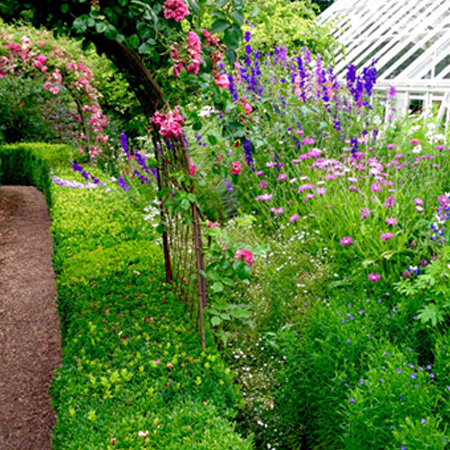 |
